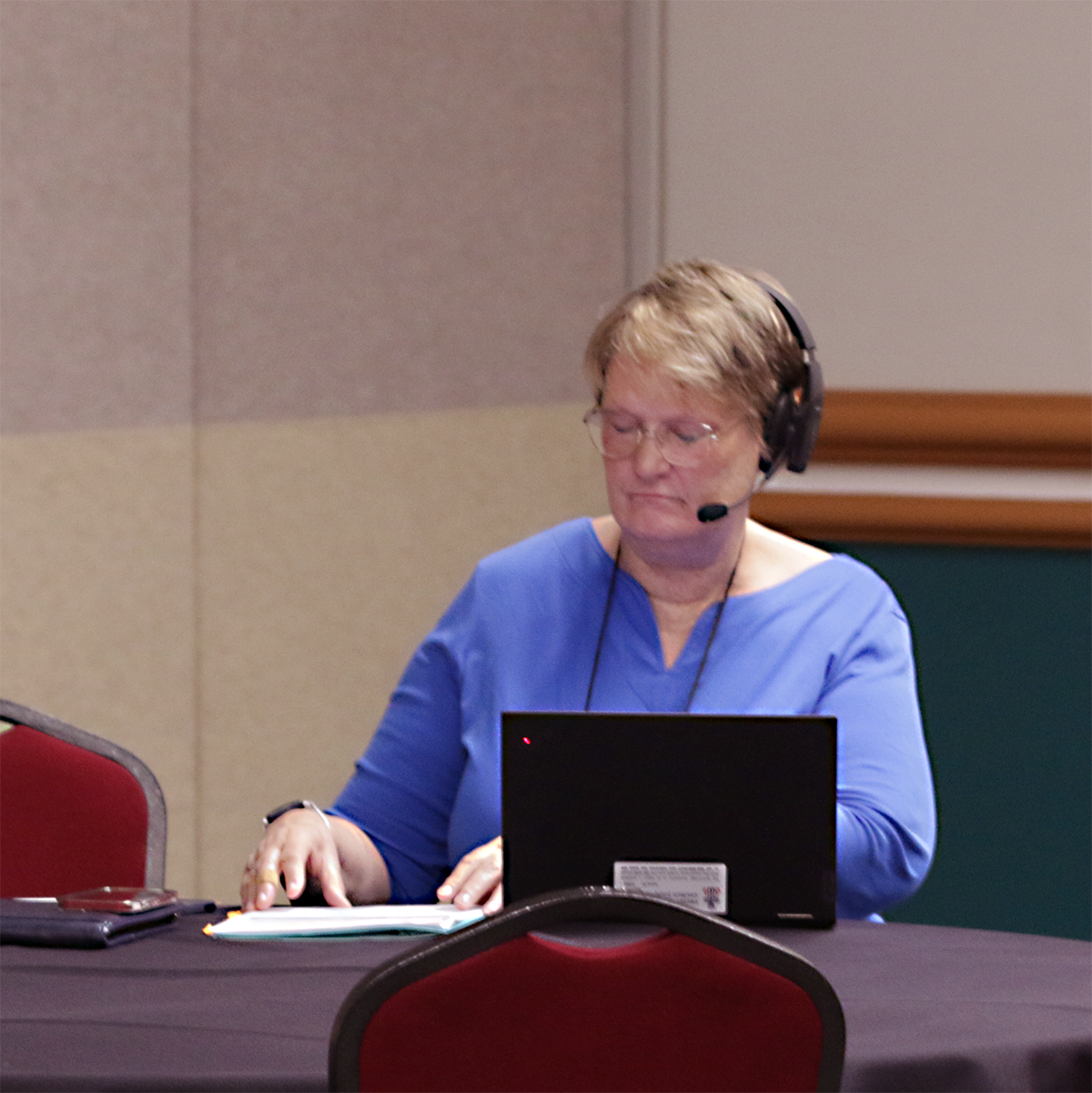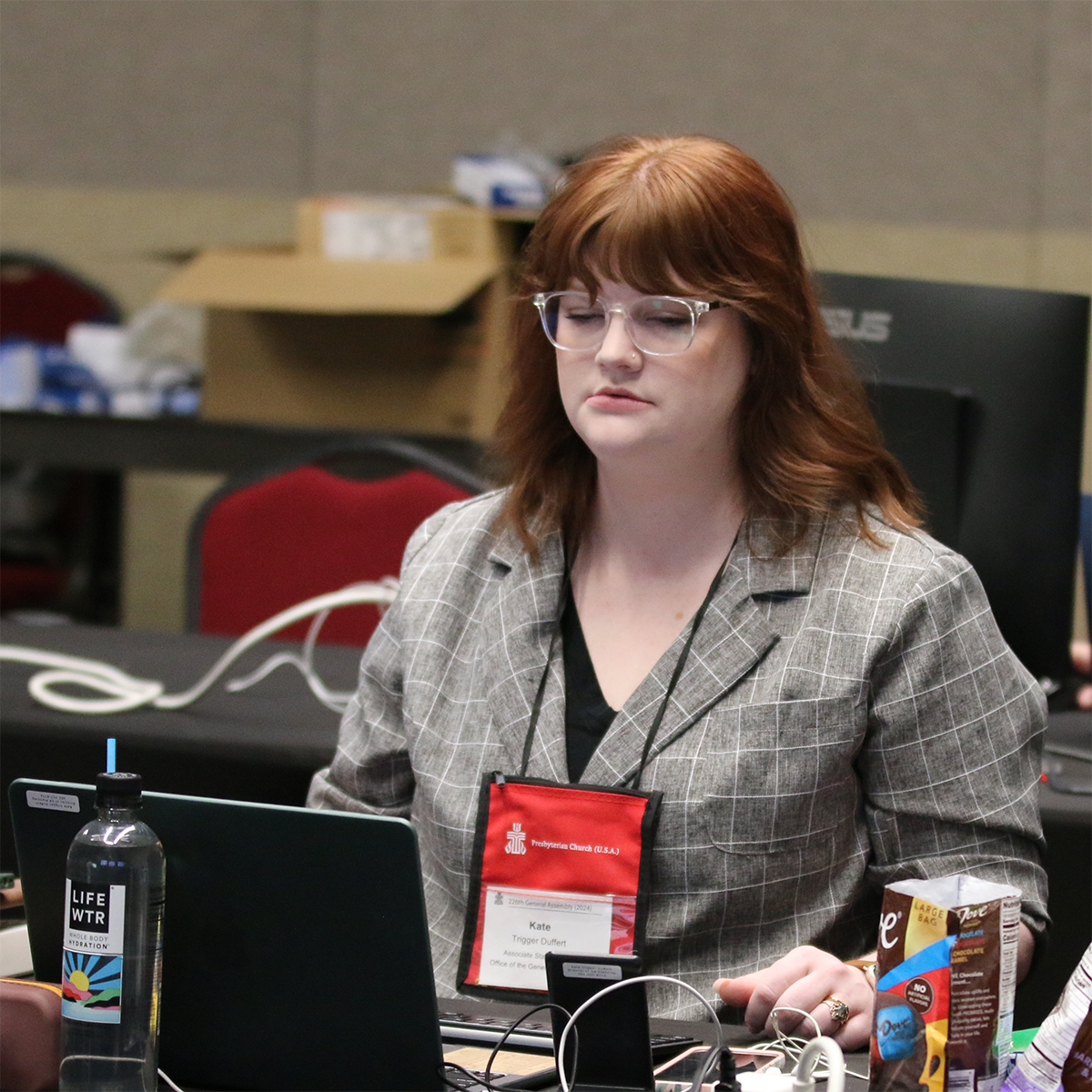
The Rev. Bronwen Boswell prepares for discussion with committees on June 27, 2024 during the 226th General Assembly in Salt Lake City. Photo by Randy Hobson

The Rev. Bronwen Boswell prepares for discussion with committees on June 27, 2024 during the 226th General Assembly in Salt Lake City. Photo by Randy Hobson
While online General Assembly committee work may have gotten off to a slow start on Tuesday, “we got into a rhythm,” noted the Rev. Bronwen Boswell, Acting Stated Clerk of the General Assembly of the Presbyterian Church (U.S.A.). “Once people got used to it, we heard little more about any technical issues. It was getting into the rhythm of being a committee, and it went well.”
“People had differing experiences with the technology,” Boswell noted. “With some [commissioners and advisory delegates], it’s second nature, but for others it’s very new. That’s where we’re at in this changing world, trying to include a wide swath of ages and people” to attend General Assembly.
Along with Kate Trigger Duffert, manager of General Assembly Planning in the Office of the General Assembly, Boswell said she’s grateful for people who “showed up and brought their best selves. I appreciated that very much.”
An innovation for the 226th General Assembly was “the staffing structure we came up with to support committee leaders,” Trigger Duffert said. People were on hand to support the moderators and vice-moderators leading the 12 committees. While committee leaders ran the online meetings from rooms in the Salt Palace Convention Center, “they were never left without support,” Trigger Duffert said. “Getting information out to committee leaders was huge.”
What planners also found was “the first way someone does work [preparing for the assembly] is through technical services on their own,” Trigger Duffert said, using training modules to learn about about how to use online tools to follow the committee’s business, seek recognition, make motions and the like. “We’ve used these tools before, but learning something new when you are isolated is a challenge.”
Commissioners and advisory delegates were required to complete their technology training, but some struggled with the online tools during the early stages of committee meetings. “If you trained, you were on top of it,” Trigger Duffert said. “If you didn’t, the entire committee’s work was kind of confused,” especially on Tuesday, the first day of online committee meetings.
The major upgrade that most committee members noticed was the improved functionality of MyGA, where users could readily follow committee business as it happened. “You could pick what committee you want to watch,” Trigger Duffert said.

Kate Trigger Duffert, manager of General Assembly planning follows committee business on June 26, 2024. Photo by Randy Hobson

Kate Trigger Duffert, manager of General Assembly planning follows committee business on June 26, 2024. Photo by Randy Hobson
On Wednesday afternoon, the GA team shut down committee action for about 30 minutes out of concern for how heavily the server was being used. “We were grateful we could fix things so fast,” Trigger Duffert said. “When the technology doesn’t work, we shut it down to fix it.”
Plans for future assemblies include making the MyGA format even stronger. “We will perfect the format like you perfect a motion,” she said.
The GA planning team has expanded from previous GAs. “We’re leaning into people’s gifts and skills and putting them in roles where they can live that out,” she said. That way, people are doing “the thing they know, and can work together and not feel overburdened.”
Long months of planning paid off during the initial stage of the 226th General Assembly.
“When things weren’t going well, we were ready. I think we planned that pretty well. When things went wrong, we had the right people to fix it,” Trigger Duffert said. She and Boswell have “talked about pulling back the curtain” so that “people realize there is so much more happening to make sure that things will run smoothly.”
“Our MO at General Assembly used to be ‘don’t notice us,’” Trigger Duffert said. “We’re saying, ‘no, notice us. We are part of this together, and we need to recognize the full scope of the community that’s making this happen.”
Commissioners, advisory delegates and others will notice the technology will be essentially the same once plenaries begin on Sunday.
“We didn’t want them to have to learn multiple systems,” Trigger Duffert said. The main difference will be that once commissioners and advisory delegates seek recognition, MyGA will tell them which microphone to go to. Gone, she said, are the colorful paddles that longtime GA observers will fondly recall.
“We hope people pair their excitedness to be here with an openness to experience a new form of assembly and find how we can be creative with our tools and approaches” and still “find familiarity in our ability to answer the call at the assembly.”
“It’s going to feel a little different,” Trigger Duffert predicted, “but other parts will feel the same.”
